Where
Description
Part of the Salmons Brook Healthy River Challenge, an initiative designed to improve water quality in the Salmons Brook and its tributaries by tackling urban diffuse pollution. Enfield has a predominantly separate sewage system, meaning that surface water and wastewater are carried in two separate pipes. As a result, pollutants enter the watercourses in a number of different ways. Misconnected plumbing contributes phosphates, nitrates and coliform bacteria etc., road run-off inputs oils and heavy metals such as zinc and copper, and household and industrial waste is dumped into surface water drains. This pollution is particularly evident during dry periods when there is little rain to dilute misconnection flows.
In autumn 2015 Thames21 worked with the London Borough of Enfield to create two rain gardens to improve the water quality in the Houndsden Gutter, a tributary of Salmons Brook. They have been designed to treat polluted runoff from Houndsden Road, preventing oils and heavy metals washing into the Houndsden Gutter. The stream supports a small fish population, and fish are seriously impacted by such pollutants, just one reason why reducing the pollutant levels in the stream is important.
SuDS components used
- Swales
- Rain gardens
In the first rain garden runoff is directed along the verge in a shallow swale and into the natural woodland basin of the spinney, where chemicals which would pollute the river are filtered out and broken down by biological processes within plants and the surrounding soil. The swales have been planted with sedges and native grasses to slow water flow and begin the treatment, and the woodland basin planted with suitable native seed mixes. Water will then naturally soak into the soil, recharging the water table. This is particularly important during times of summer drought.
The second rain garden system works in the same principle, diverting road runoff through swales and two planted basins, with capacity for an overflow route during times of very heavy rainfall.
Two road gullies have been made redundant and filled which reduces the quantity of water contributing to the sewer system.
How it works
The intervention here is comprised of two systems, phase 1 and phase 2, created approximately 6 months apart.
In phase 1 a gully was filled and the kerb lowered to create an inlet, taking care to ensure this was situated some distance away from utility installations. The inlet allows runoff to flow into a treatment swale meandering through the grass verge, planted with pendulous sedge. See figure 1 of the construction.
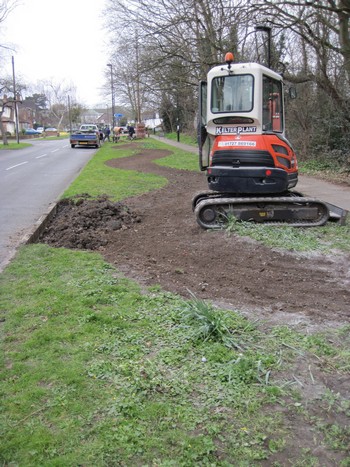 |
| Figure 1. Constructing the swales |
A second kerb inlet joins the swale before running underneath the pavement beneath a shallow pavement bridge (figure 2). It then continues into a natural woodland basin which is planted with a woodland seed mix. Some small trees were removed here in consultation with the council’s Arboricultural Officer. The water is slowed and treated in both the swale and the woodland basin before infiltrating to help recharge groundwater.
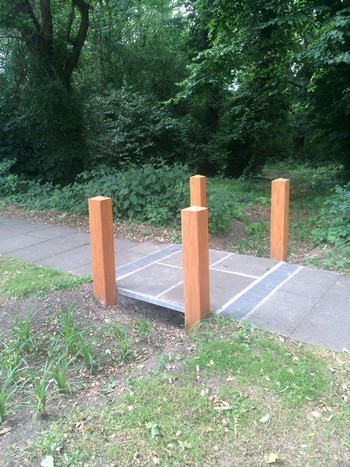 |
| Figure 2. Pavement bridge |
In the second system (phase 2) the swale instead leads into a rain garden basin sized at 1.9m3 storage volume to store a 1 in 2 year storm at depth of 200mm. An underdrained swale then takes excessive flows into a larger rain garden basin with storage volume of 2.5m3 at 240mm depth, designed to deal with a 1 in 30 year storm event. This in turn has a flow control outlet, which leads to a pipe running beneath the footpath and bund and into the woodland glade through a basket inlet to account for unprecedented storm events. The phase 2 system is planted with pendulous sedge, and also a native clay soils mix.
The plants in the swales and raingardens have added ecological and aesthetic benefit to the verge here which was previously just short mown amenity grass. The system also reduces the flood risk to the road and homes.
Maintenance & operation
The swales and woodland basins require occasional vegetation management approximately once or twice per year. This is the responsibility of Thames21 who have worked with dedicated local volunteers to establish and control vegetation and clear litter when necessary (see figure 3 of volunteers weeding the swale).
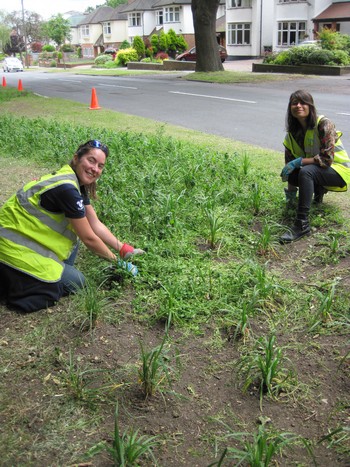 |
| Figure 3. Volunteers weeding the swale |
Checks must be undertaken to ensure that runoff can flow into and out of the swales, raingardens and basins. This is easily checked just with a visual inspection and can be done by Thames21 or volunteers.
The flow control structure from the second rain garden and basket inlet to the overflow into woodland glade are monitored and maintained by the landowner, London Borough of Enfield. They have agreed to take on the long term structural maintenance of the system, making them sustainable public assets.
Monitoring & evaluation
Fixed point photography is being used to chart the development of the SuDS.
Benefits
As it is situated on a busy road this system is an excellent showcase for SuDS. It collects runoff from a 140m stretch of carriageway, preventing the pollution washing into the stream.
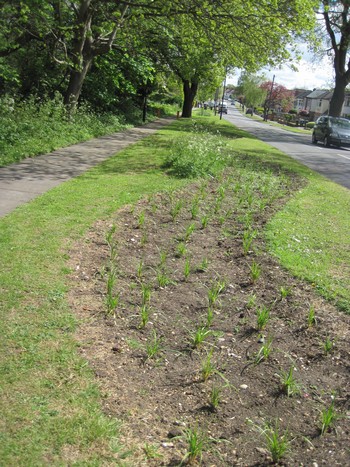 |
| Figure 4. Newly planted swale |
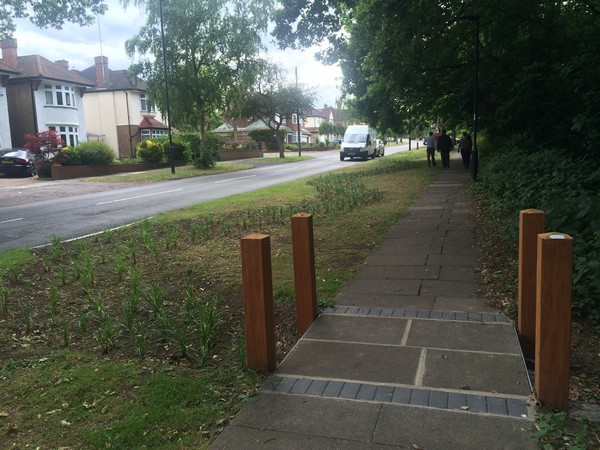 |
| Figure 5. Completed swale |
Lessons learnt
We wanted to measure any water quality improvements that could be attributes to this system. However due to water sampling being constrained to fixed days, water was not sampled running into the swale at Houndsden Road. This was because rainfall on sampling days was insufficient to capture surface flow off the roads. Data for this site could therefore not be presented in our subsequent analyses.
Ideally we would establish a network of local volunteers who could respond to rainfall events and collect samples for us to analyse, but the logistics of doing this in a timely way is difficult.
The establishment of sedges proved difficult in the phase 2 swale and rain gardens. It is likely that this is related to light conditions (being too strong) and lack of rainfall after planting. One year on they are beginning to take hold. Some residents expressed concern about the lack of sedges and proliferation of weeds in the phase 2 system, so we weeded and put in some more sun-loving native wildflower species.
The scheme which was delivered was not as ambitious as the original plan which included diversion of the stream through the wet woodland to achieve extensive treatment to improve the water quality. However this was not acceptable to the Environment Agency due to concerns about fish passage which unfortunately could not be overcome. Therefore, just the road runoff treatment was delivered.
Interaction with the local authority
Working in partnership was key to the project’s success. A steering group was formed from Thames21 and London Borough of Enfield (LBE) Structures and Watercourses team, along with others. This provided a broad scope of experience and knowledge, guiding the process of planning and design, and helping with issues encountered in implementation of the initial sites.
Support from numerous council departments was forthcoming, especially Parks and Highways.
Project details
Total cost under £35,000 (design and construction).
Planning began in September 2012.
Construction and planting of phase 1 spring 2015, and phase 2 in autumn 2015.
Weeding and re-planting of some more diverse species in the phase 2 system summer 2016.
Project partners (and funders)
London Borough of Enfield (steering the project and land owners).
Environment Agency (advice and support).
Defra (funding).
Thames water and funding for latter part of project (2015-16).
Project team
Project management and engagement: Thames 21.
Landscape architect: Robert Bray Associates.
Contractors: Maydencroft.
Maintenance: Thames21 working with local volunteers.


